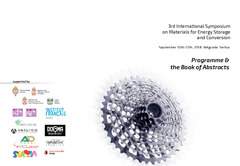Prikaz osnovnih podataka o dokumentu
Synthesis and characterization of Nb-doped lanthanum nickelate La(Ni,Nb)O3
| dc.creator | Vukašinović, Jelena | |
| dc.creator | Počuča-Nešić, Milica | |
| dc.creator | Luković Golić, Danijela | |
| dc.creator | Branković, Zorica | |
| dc.creator | Dapčević, Aleksandra | |
| dc.creator | Branković, Goran | |
| dc.date.accessioned | 2023-08-07T09:06:35Z | |
| dc.date.available | 2023-08-07T09:06:35Z | |
| dc.date.issued | 2018 | |
| dc.identifier.isbn | 978-86-7306-140-5 | |
| dc.identifier.uri | http://rimsi.imsi.bg.ac.rs/handle/123456789/2034 | |
| dc.description.abstract | Perovskite type ceramic materials with general formula ABO3 are very important class of materials due to their various chemical and physical properties. They have wide applications such as electrode material for solid state fuel cells (SOFC), capacitors, resistors, superconductors, catalysts, electrolytes, microwave devices, and magnetoresitant materials [1, 2]. Lanthanum nickelate (LaNiO3, LNO) is a ternary oxide with rhombohedrally distorted perovskite lattice. In LNO trivalent nickel ions (Ni3+) are in low spin configuration (t2g 6eg 1) and the conduction band is formed by the hybridization of the egorbitals of Ni3+ and the p-orbitals of oxygen. As a result, LNO shows metallic n-type conductivity in wide temperature range [3]. For this reason LNO has been proposed as a cathode material for intermediate-temperature SOFCs (IT-SOFCs) with operating temperature range of 650-800 °C. The possible dawbacks of LNO as a potential material for this application are poor density and thermal unstability at temperatures higher than 850 °C, when LNO starts gradually to decompose into the lower oxides Lan+1NinO3n+1 (n = 3, 2, 1) and NiO. Still, all of these La-Ni-O compounds exhibit high electronic conduction within the NiO6 octahedra in their perovskite layers and excellent oxygen ionic conductivity through oxygen interstitials on the LaO rock-salt plane. Also, their coefficient of thermal expansion (CTE) matches those of materials commonly used as IT-SOFC electrolyte and anode [1]. A possible use of LNO as a cathode for SOFC requires the improvement of its thermal stability and enhancement of density of ceramic samples. The aim of this work was to fullfill these requirements by doping of lanthanum-nickelate into the B site. Using transition metal of higher valency than Ni3+ as a dopant, could enhance the electron concentration and carrier mobility, which results in improvement of electrical conductivity of ceramic material. Doping could also influence the sintering process and improve the density of the ceramic materials. In this work we present dense ceramic materials of LaNi1- xNbxO3 (x = 0.005, 0.05) prepared by mechanochemically assisted solid state method. La2O3, NiO and Nb2O5, used as a precursor reagents, were mechanochemically activated in the planetary ball mill for 5 h. Obtained powders were calcined at 700 °C for 3h in air, and afterwards sintered at 900 °C and 1200 °C for 2 h and 10 h in different atmospheres (air and oxygen). The influence of Nb doping on electrical properties and microstructure of LaNi1-xNbxO3 ceramic materials was investigated. All samples were analyzed by X-ray diffraction analysis (XRD), scanning electron microscopy (SEM) and energy dispersive X-ray spectroscopy (EDS). Electrical conductivity of ceramic LaNi1-xNbxO3 samples was measured in different mediums and complete characterization of electrical properties was performed. The XRD analysis indicated the existence of secondary phases Lan+1NinO3n+1 and NiO along with the rhombohedral LaNiO3. Samples sintered at 900 °C in oxygen atmosphere for 2 h had density of 64 % and 60 % for x = 0.005 and x = 0.05 (Fig. 1). The electrical conductivity was improved by doping with Nb, and obtained values were 2.7 S cm and 2.6 S cm for x = 0.005 and x = 0.05 at room temperature. The obtained results confirmed that doping by Nb along with sintering in oxygen atmosphere can improve electrical conductivity, density, and thermal stability. References [1] R.K. Sharma, E. Djurado, J Mater Chem A, 5 (2017) 22277-22287. [2].A. S. Bhalla, R. Guo, R. Roy, Mat Res Innovat, 4 (2000) 3-26. [3] K. Sreedhar et al., Phys Rev B, 46 (1992) 6382-6386. | sr |
| dc.language.iso | en | sr |
| dc.publisher | University of Belgrade, Vinča Institute of Nuclear Sciences | sr |
| dc.publisher | Hydrogen Economy Initiative Serbia, Belgrade | sr |
| dc.rights | openAccess | sr |
| dc.source | 3rd International Symposium on Materials for Energy Storage and Conversion, mESC-IS, September 10-12, 2018, Belgrade, Serbia | sr |
| dc.subject | Perovskite materials | sr |
| dc.subject | IT-SOFCs | sr |
| dc.subject | Lanthanum nickelate | sr |
| dc.subject | Nb-doping | sr |
| dc.subject | Electrical conductivity | sr |
| dc.title | Synthesis and characterization of Nb-doped lanthanum nickelate La(Ni,Nb)O3 | sr |
| dc.type | conferenceObject | sr |
| dc.rights.license | ARR | sr |
| dc.citation.spage | 78 | |
| dc.identifier.fulltext | http://rimsi.imsi.bg.ac.rs/bitstream/id/5361/bitstream_5361.pdf | |
| dc.identifier.rcub | https://hdl.handle.net/21.15107/rcub_rimsi_2034 | |
| dc.type.version | publishedVersion | sr |

